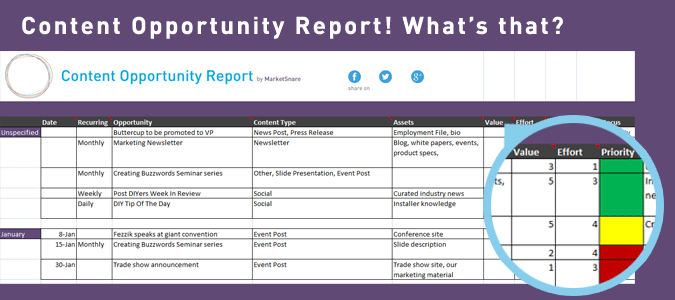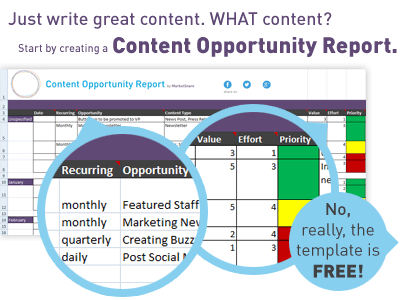The Importance of Analytics in Your Multi-Location Local Marketing Strategy
As multi-location marketing professionals, we understand the importance of data-driven decision making. It is often said that the first step toward...
3 min read
![]() MarketSnare
:
Mar 10, 2014
MarketSnare
:
Mar 10, 2014

Over the past several years much has been said and written on the subject of editorial calendars. But few people have specifically addressed methodologies for taking inventory of valuable opportunities, which should precede the creation of such calendars. I want to introduce you to something I call a Content Opportunity Report, or COR.
 Quite simply, a content opportunity report is a strategic and systematic way of looking for, and making note of, known and suspected opportunities for content creation. It’s an inventory of assets, timetables, and ideas, if you will. Known opportunities are, of course, those that are already scheduled, expected to occur, or deemed worthy of pursuit. Content suspects would be those that may or may not occur, but aren’t outside the realm of possibility or value. While nuanced, I believe the distinction between an editorial calendar – certainly the oversimplified type that some refer to – and a Content Opportunity Report is significant.
Quite simply, a content opportunity report is a strategic and systematic way of looking for, and making note of, known and suspected opportunities for content creation. It’s an inventory of assets, timetables, and ideas, if you will. Known opportunities are, of course, those that are already scheduled, expected to occur, or deemed worthy of pursuit. Content suspects would be those that may or may not occur, but aren’t outside the realm of possibility or value. While nuanced, I believe the distinction between an editorial calendar – certainly the oversimplified type that some refer to – and a Content Opportunity Report is significant.
In creating a COR, you must factor in what you are able to do from a resource perspective, and what you are willing to do from an organizational, employee participation, and ownership buy-in perspective. But, let’s not worry about that now, let’s focus on ideation and content opportunity inventory.
Let’s look at a few – by no means all – opportunities for time-specific content:
Product launches, rollouts, requests for general information, reviews, walkthroughs, or updates
Anniversaries or scheduled promotions
Deals, coupons, sales, offerings, and end-of-year extravaganzas
Games or contests, which may or may not tie into promotions
Timed campaigns, or content that coincides with other marketing channel releases
Event promotion before, and wrap-up or results after (and depending on the duration, maybe even some real-time or daily coverage during) the event
Conferences, trade shows, webinars, seminars, interviews, and speaking engagements related to an event
Holidays, festivals, on-this-day, or events, quirky, or otherwise, that occur every year – such as those found via sites like Days of the Year.
Now let’s look at a few example opportunities that have unspecified times but are likely to occur, depending on your business type or what could be scheduled as a series. For example, if your company has had an average of 5 significant findings over the past several years, note them as a potential opportunity so you can take advantage of them. If you yearly submit for design awards or patents and are awarded, that represents content opportunity. Other examples include:
Behind the scenes, staff highlight, who we are, and “the life of” blog post series.
Advancements, professional or industry breakthroughs
Case studies, white papers, and publications
Recent hires or job opportunities
Awards, recognitions, and PR opportunities associated with annual events that you commonly participate in
Unscheduled updates, fixes, patches, etc.
Blog posts, series, how-to guides, and commentary related to normal industry news and changes
Other smaller or impromptu events
How To, Question-and-Answer, or live demo sessions
These items could follow a similar format even if the content itself changes. Once you have decided this has value to the company, a repeatable format can be created and the task can be assigned and added to the editorial calendar appropriately.
Now let’s talk about things that pop up unexpectedly. Planning for all of the above allows you to potentially capitalize on unexpected content opportunities, or to seek them out. Unexpected opportunities could arise from:
Awards, news coverage, press events, PR, etc.
Guest posts, editorials, or various appearances, which you will mention on your site, of course.
Speaking engagements not planned in advance
User-generated content
Newsjacking (if you are into that kind of thing)
What we now need to consider is that each of the aforementioned content opportunities may fit into and be repurposed into multiple formats, like:
Blog posts
Social posts
News
Landing pages
Squeeze pages
eBooks
Press Releases
Teasers
Case studies
Infographics
White papers
Slide decks/presentations
Newsletters or email campaigns
FAQs
Podcasting
Videos: short form, long form, live or Memorex
Other imagery, motion graphics, memes, etc.
Deciding which delivery channels or formats, or which combinations of them, work best may be part of what you consider in developing your COR or relegated to your editorial calendar discussion. The object of the COR is to establish that value and opportunity exist. The details of how to maximize visibility, reach, and conversion will come later with the development of a content-specific strategy.
Why go through such an exhaustive process to discover potential content? Because doing so sets direction and priorities for whatever SEO, Inbound (or Content) Marketing, email campaigns, social media marketing, or other efforts you undertake over the next year to help boost traffic and lead generation.
Ready to get started? Download our free Content Opportunity Report tool here.

As multi-location marketing professionals, we understand the importance of data-driven decision making. It is often said that the first step toward...

Whether you're a corporate marketer at a franchise or a local franchise owner, you know that ranking in the Google Map Pack is crucial to your...

In today’s digital age, businesses that operate across multiple locations face unique challenges when it comes to marketing and building their online...